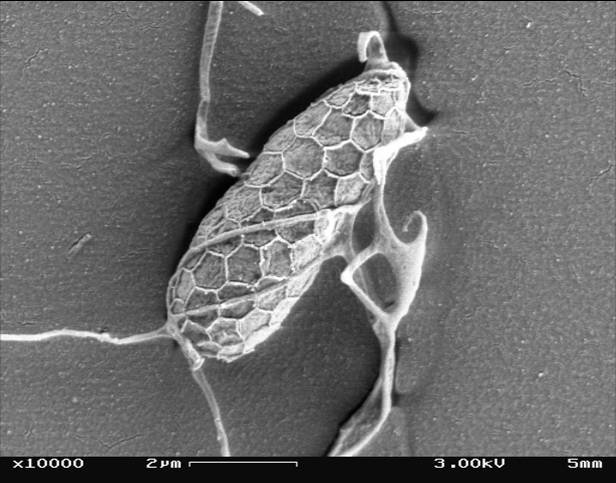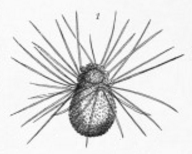|
Stramenopiles
The stramenopiles, also called heterokonts, are Protist, protists distinguished by the presence of stiff tripartite external hairs. In most species, the hairs are attached to flagella, in some they are attached to other areas of the cellular surface, and in some they have been secondarily lost (in which case relatedness to stramenopile ancestors is evident from other shared cytological features or from genetic similarity). Stramenopiles represent one of the three major clades in the SAR supergroup, SAR Supergroup (biology), supergroup, along with Alveolate, Alveolata and Rhizaria. Stramenopiles are Eukaryote, eukaryotes; most are single-celled, but some are multicellular including some large seaweeds, the brown algae. The group includes a variety of algal protists, heterotrophic flagellates, opalines and closely related proteromonad flagellates (all Endosymbiont, endobionts in other organisms); the actinophryid Heliozoa, and oomycetes. The tripartite hairs characteristic of the ... [...More Info...] [...Related Items...] OR: [Wikipedia] [Google] [Baidu] |
Bigyra
Bigyra () is a phylum of microscopic eukaryotes that are found at the base of the Stramenopiles clade. It includes three well-known heterotrophic groups Bicosoecida, Opalinata and Labyrinthulomycetes, as well as several small clades initially discovered through environmental DNA samples: Nanomonadea, Placididea, Opalomonadea and Eogyrea. The classification of Bigyra has changed several times since its origin, and its monophyly remains unresolved. Ecological diversity Bigyra is a diverse group of heterotrophic, mainly phagotrophic stramenopiles that lack cell walls. It contains three well-known important groups with widely different ecological functions and morphologies: labyrinthulomycetes, opalines and bicosoecids. Labyrinthulomycetes is a group of protists that absorb nutrients in an osmotrophic or phagotrophic manner. They can behave either as free-living amoebae or as mycelium-like networks of cytoplasmic threads. Some of them are saprotrophic decomposers of the detritus, de ... [...More Info...] [...Related Items...] OR: [Wikipedia] [Google] [Baidu] |
Ochrophyte
Ochrophytes, also known as heterokontophytes or stramenochromes, are a phylum of algae. They are the photosynthetic stramenopiles, a group of eukaryotes, organisms with a cell nucleus, characterized by the presence of two unequal flagella, one of which has tripartite hairs called mastigonemes. In particular, they are characterized by photosynthetic organelles or plastids enclosed by four membranes, with membrane-bound compartments called thylakoids organized in piles of three, chlorophyll ''a'' and ''c'' as their photosynthetic pigments, and additional pigments such as β-carotene and xanthophylls. Ochrophytes are one of the most diverse lineages of eukaryotes, containing ecologically important algae such as brown algae and diatoms. They are classified either as phylum Ochrophyta, Heterokontophyta or as subphylum Ochrophytina withing phylum Gyrista. Their plastids are of red algal origin. Description Ochrophytes are eukaryotic organisms composed of cells that are eithe ... [...More Info...] [...Related Items...] OR: [Wikipedia] [Google] [Baidu] |
Protist
A protist ( ) or protoctist is any eukaryotic organism that is not an animal, land plant, or fungus. Protists do not form a natural group, or clade, but are a paraphyletic grouping of all descendants of the last eukaryotic common ancestor excluding land plants, animals, and fungi. Protists were historically regarded as a separate taxonomic kingdom known as Protista or Protoctista. With the advent of phylogenetic analysis and electron microscopy studies, the use of Protista as a formal taxon was gradually abandoned. In modern classifications, protists are spread across several eukaryotic clades called supergroups, such as Archaeplastida ( photoautotrophs that includes land plants), SAR, Obazoa (which includes fungi and animals), Amoebozoa and " Excavata". Protists represent an extremely large genetic and ecological diversity in all environments, including extreme habitats. Their diversity, larger than for all other eukaryotes, has only been discovered in rece ... [...More Info...] [...Related Items...] OR: [Wikipedia] [Google] [Baidu] |
Gyrista
Gyrista is a clade of stramenopile protists containing three diverse groups: the mostly photosynthetic Ochrophyta, the parasitic Pseudofungi, and the recently described group of nanoflagellates known as Bigyromonada. Members of this phylum are characterized by the presence of a helix or a double helix/ring system in the ciliary transition region. Systematics Taxonomic history Gyrista was first described in 1998 by protistologist Thomas Cavalier-Smith in his work ''A revised six-kingdom system of life'', originally as a superphylum containing two phyla: Ochrophyta, the heterokont algae; and Bigyra, which then contained the pseudofungi and bigyromonads together with the opalines. Later, the name Bigyra was modified to contain opalines, bicosoecids and labyrinthulomycetes, while the Ochrophyta, Pseudofungi and Bigyromonada remained as groups within Gyrista. Molecular phylogenetics Gyrista was seen in 2017 as the sister group to phylum Bigyra, which contains the Sag ... [...More Info...] [...Related Items...] OR: [Wikipedia] [Google] [Baidu] |
Labyrinthulomycetes
Labyrinthulomycetes (ICNafp) or Labyrinthulea (ICZN) is a class of protists that produce a network of filaments or tubes, which serve as tracks for the cells to glide along and absorb nutrients for them. The two main groups are the labyrinthulids (or slime nets) and thraustochytrids. They are mostly marine, commonly found as parasites on algae and seagrasses or as decomposers on dead plant material. They also include some parasites of marine invertebrates and mixotrophic species that live in a symbiotic relationship with zoochlorella. Characteristics Although they are outside the cells, the filaments of Labyrinthulomycetes are surrounded by a membrane. They are formed and connected with the cytoplasm by a unique organelle called a sagenogen or bothrosome. The cells are uninucleated and typically ovoid, and move back and forth along the amorphous network at speeds varying from 5-150 μm per minute. Among the labyrinthulids, the cells are enclosed within the tubes, and ... [...More Info...] [...Related Items...] OR: [Wikipedia] [Google] [Baidu] |
SAR Supergroup
SAR is a highly diverse clade of eukaryotes, often considered a supergroup, that includes stramenopiles (heterokonts), alveolates, and rhizarians. It is a node-based taxon (under the Sar name), including all descendants of the three groups' last common ancestor, and comprises most of the now-rejected Chromalveolata. Their sister group has been found to be telonemids, with which they make up the TSAR clade. Harosa is sometimes used synonymously with TSAR. Etymology The name SAR is an acronym derived from the first letters of its three constituent clades; it has been alternatively spelled RAS. The term Harosa (at the subkingdom level) has also been used, with Stramenopiles replaced by its synonym Heterokonta in this variant of the acronym. History of discovery Before the discovery of the SAR supergroup, stramenopiles and alveolates were classified in the supergroup Chromalveolata alongside haptophytes and cryptomonads, being believed to have acquired plastids th ... [...More Info...] [...Related Items...] OR: [Wikipedia] [Google] [Baidu] |
Brown Algae
Brown algae (: alga) are a large group of multicellular algae comprising the class (biology), class Phaeophyceae. They include many seaweeds located in colder waters of the Northern Hemisphere. Brown algae are the major seaweeds of the temperate and polar regions. Many brown algae, such as members of the order Fucales, commonly grow along rocky seashores. Most brown algae live in marine environments, where they play an important role both as food and as a potential habitat. For instance, ''Macrocystis'', a kelp of the order Laminariales, may reach in length and forms prominent underwater kelp forests that contain a high level of biodiversity. Another example is ''Sargassum'', which creates unique floating mats of seaweed in the tropical waters of the Sargasso Sea that serve as the habitats for many species. Some members of the class, such as kelps, are used by humans as food. Between 1,500 and 2,000 species of brown algae are known worldwide. Some species, such as ''Ascophyllum ... [...More Info...] [...Related Items...] OR: [Wikipedia] [Google] [Baidu] |
Platysulcus
''Platysulcus tardus'' () is a eukaryotic microorganism that was recently discovered to be the earliest diverging lineage of the stramenopile phylogenetic tree. It is the only member of the family Platysulcidae, order Platysulcida and class Platysulcea. Morphology ''Platysulcus'' is a gliding biflagellate, with a short anterior flagellum, a long posterior flagellum, and a flagellar apparatus typical of stramenopiles. It has tubular mastigonemes on the anterior flagellum. It contains mitochondria with tubular cristae. The basal body and the transitional region of the flagella lack ring-shaped or helical structures. The two flagellar roots consist of 11 microtubules forming an “L”-shape. Its cells are oval or ovoid in shape, around 5.62 μm in length and 3.76 μm in width. The anterior flagellum is around 9 μm in length, and the posterior measures around 17 μm. They contain extrusomes and a large, flat vesicle surrounding the cytoplasm where the nucleus, mitochondria, and ... [...More Info...] [...Related Items...] OR: [Wikipedia] [Google] [Baidu] |
Kaonashia
''Kaonashia insperata'' is a species of single-celled phagotrophic stramenopiles. Described in 2023 from flagellates found in a soda lake, it is the sole species within the genus ''Kaonashia'' and family Kaonashiidae. Cells of this organism have cortical alveoli, extrusomes, a ventral groove, a short anterior flagellum covered in mastigonemes, and a longer posterior flagellum covered in thinner hairs. The cells are most similar to those found in developayellids, but a molecular phylogenetic analysis found no well-supported affinity to any specific stramenopile group. Etymology The genus ''Kaonashia'' is named after the fictional ghost from the Hayao Miyazaki film ''Spirited Away''. The specific epithet ''insperata'' () references the unanticipated phylogenetic placement of this organism given its appearance. Description Cellular organization ''Kaonashia insperata'' is a species of free-living phagotrophic flagellates. The cells are roughly ovoid or bean-shaped, 7–13 μm ... [...More Info...] [...Related Items...] OR: [Wikipedia] [Google] [Baidu] |
Rhizaria
The Rhizaria are a diverse and species-rich clade of mostly unicellular eukaryotes. Except for the Chlorarachniophytes and three species in the genus '' Paulinella'' in the phylum Cercozoa, they are all non-photosynthetic, but many Foraminifera and Radiolaria have a symbiotic relationship with unicellular algae. A multicellular form, ''Guttulinopsis vulgaris'', a cellular slime mold, has been described. This group was used by Cavalier-Smith in 2002, although the term "Rhizaria" had been long used for clades within the currently recognized taxon. Being described mainly from rDNA sequences, they vary considerably in form, having no clear morphological distinctive characters ( synapomorphies), but for the most part they are amoeboids with filose, reticulose, or microtubule-supported pseudopods. In the absence of an apomorphy, the group is ill-defined, and its composition has been very fluid. Some Rhizaria possess mineral exoskeletons ( thecae or loricas), which are in diffe ... [...More Info...] [...Related Items...] OR: [Wikipedia] [Google] [Baidu] |
Silicoflagellate
The silicoflagellates (order Dictyochales) are a small group of unicellular photosynthetic protists, or algae, belonging to the supergroup of eukaryotes known as Stramenopiles. They behave as plankton and are present in oceanic waters. They are well-known from harmful algal blooms that cause high mortality of fish. Additionally, they compose a rich fossil record represented by their silica skeletons. Morphology The silicoflagellates are unicellular protists, composed of cells with one emergent flagellum and a siliceous skeleton constructed from a network of hollow rods outside of the cytoplasm. The morphology of the skeleton can vary greatly, from a simple ring, an ellipse or triangle, to a more complex and complete arrangement of rods. For example, in '' Dictyocha fibula'' (pictured) the skeleton rods are arranged in a series of peripheral polygons surrounding a central hexagon. These skeletons form a small component of marine sediments, and are well-known microfossils ... [...More Info...] [...Related Items...] OR: [Wikipedia] [Google] [Baidu] |








